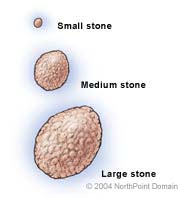Removal of urinary stones was a painful and, sometimes, dangerous procedure in the past, requiring 4 to 6 weeks of bed rest after the operation. Today, there are several minimally invasive procedures to choose from and major surgery is seldom required.The primary goals of stone disease treatment are:
- Relief of pain;
- Elimination of infection caused by urinary stones;
- Removal of obstructions preventing proper flow of urine; and
- Prevention of new stone formation.
Minimally invasive procedures remove a urinary stone and include lithotripsy and ureterorenoscopy. When minimally invasive procedures fail to rid the person of the stone, or anatomical abnormalities are present, the physician may resort to surgical procedures such as percutaneous nephrolithotomy or traditional surgery.
WHEN IS THE TREATMENT INDICATED?
In most cases, small urinary stones eventually will pass harmlessly through the ureter, bladder, and urethra to exit the body on their own. If the stone is not expelled or it presents an immediate threat to a patient’s health, minimally invasive or surgical procedures are used to remove the stone.
All urinary stones should be treated to avoid serious, even life-threatening, complications. Treatment varies according to the location, size, and chemical composition of the stone.
WHAT TO EXPECT
Because small stones eventually exit the body naturally, a physician will prescribe pain medications to a patient with small stones and instruct the patient to drink as much fluid as possible to help flush out the stone.
Minimally invasive and surgical procedures to remove the stone include the following:
Lithotripsy: For smaller stones (smaller than 2 centimeters in diameter) that will not pass through the urinary system by themselves, lithotripsy is the procedure of choice. In this procedure stones are pulverized inside the body. The patient lies on a soft cushion or membrane. The physician presses the lithotripsy device against the patient’s skin and uses ultrasound or x rays to locate the stone. The lithotripsy device then sends shock waves (pressure waves similar to a sonic boom) through the body. Each shock wave makes a popping noise, and the patient will feel something similar to a gentle punch or slight sting as the shock wave travels through the body to strike the stone. The stone is struck repeatedly by the sound waves until it is broken into particles the size of grains of sand. The fragments exit the body naturally through the urinary tract. If the stones are not completely dissolved, additional treatments may be necessary.
Ureterorenoscope: A ureterorenoscope allows the surgeon to view and extract stones through the urinary opening. Once the stone has been located, the surgeon grasps it with tiny tweezers and removes it, or fragments the stone using sound waves or a laser.
Percutaneous nephrolithotomy: A surgeon makes a small puncture in the patient’s back and opens a one-quarter to one-half inch passage directly into the kidney. A guide wire is used to introduce dilators, which enlarge the opening enough for a nephroscope, a slender, fiberoptic instrument used to view the inside of a kidney and remove kidney stones. Percutaneous nephrolithotomy is used for smaller stones; for larger stones, the physician may use percutaneous lithotripsy, where a lithotripter is inserted to pulverize the stone.
Open surgery: Open, or traditional, surgery is used for patients who may have an anatomical abnormality, such as ureteropelvic junction obstruction, if the stone is so large that repeated treatments with other procedures will be necessary, or if less invasive approaches have been tried unsuccessfully.
LIFESTYLE ADJUSTMENTS
To help prevent stones from recurring, patients are advised to drink plenty of water-more than 14 cups a day-especially if they live in hot climates because increased perspiration increases the body needs for water. Since high intakes of salt, fish, beef, or poultry can cause urinary stones, a diet low in animal protein and sodium may also be recommended.

